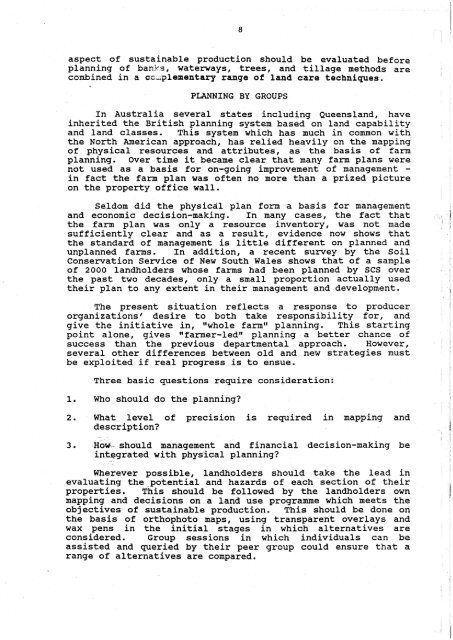soil-conservation-people-religion-and-land.pdf - South West NRM
soil-conservation-people-religion-and-land.pdf - South West NRM
soil-conservation-people-religion-and-land.pdf - South West NRM
You also want an ePaper? Increase the reach of your titles
YUMPU automatically turns print PDFs into web optimized ePapers that Google loves.
aspect of sustainable production should be evaluated before<br />
planning of banYs, waterways, trees, <strong>and</strong> tillage methods are<br />
combined in a cc,plementary range of l<strong>and</strong> care techniques.<br />
PLANNING BY GROUPS<br />
In Australia several states including Queensl<strong>and</strong>, have<br />
inherited the British planning system based on l<strong>and</strong> capability<br />
<strong>and</strong> l<strong>and</strong> classes. This system which has much in common with<br />
the North American approach, has relied heavily on the mapping<br />
of physical resources <strong>and</strong> attributes, as the basis of farm<br />
planning. Over time it became clear that many farm plans were<br />
not used as a basis for on-going improvement of management -<br />
in fact the farm plan was often no more than a prized picture<br />
on the property office wall.<br />
Seldom did the physicdl plan form a basis for management<br />
<strong>and</strong> economic decision-making. In many cases, the fact that<br />
the farm plan was only a resource inventory, was not made<br />
sufficiently clear <strong>and</strong> as a result, evidence now shows that<br />
the st<strong>and</strong>ard of management is little different on planned <strong>and</strong><br />
unplanned farms. In addition, a recent survey by the Soil<br />
Conservation Service of New <strong>South</strong> Wales shows that of a sample<br />
of 2000 l<strong>and</strong>holders whose farms had been planned by SCS over<br />
the past two decades, only a small proportion actually used<br />
their plan to any extent in their management <strong>and</strong> development.<br />
The present situation reflects a response to producer<br />
organizations* desire to both take responsibility for, <strong>and</strong><br />
give the initiative in, ltwhole farm" planning. This starting<br />
point alone, gives vmfanner-ledlf planning a better chance of<br />
success than the previous departmental approach. However,<br />
several other differences between old <strong>and</strong> new strategies must<br />
be exploited if real progress is to ensue.<br />
Three basic questions require consideration:<br />
1. Who should do the planning?<br />
2. What level of precision is required in mapping <strong>and</strong><br />
description?<br />
-<br />
3. HOT&- should management <strong>and</strong> financial decision-making be<br />
integrated with physical planning?<br />
Wherever possible, l<strong>and</strong>holders should take the lead in<br />
evaluating the potential <strong>and</strong> hazards of each section of their<br />
properties. his should be followed by the l<strong>and</strong>holders own<br />
mapping <strong>and</strong> decisions on a l<strong>and</strong> use programme which meets the<br />
objectives of sustainable production. This should be done on<br />
the basis of orthophoto maps, using transparent overlays <strong>and</strong><br />
wax pens in the initial stages in which alternatives are<br />
considered. Group sessions in which individuals can be<br />
assisted <strong>and</strong> queried by their peer group could ensure that a<br />
range of alternatives are compared.
















